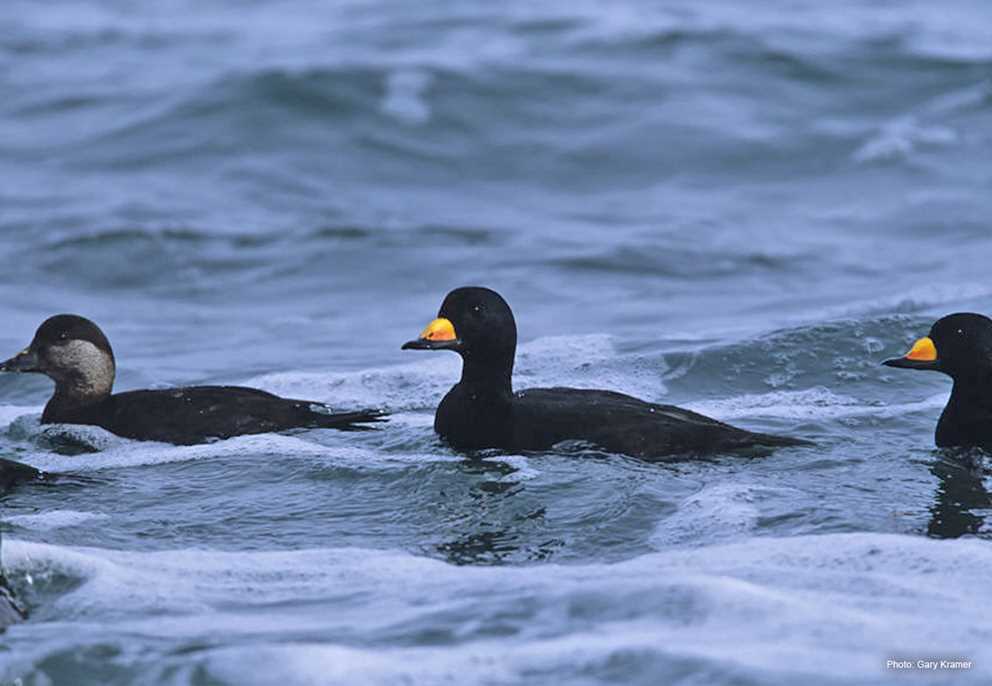Overview
Black Scoters are medium-sized sea ducks with a range restricted to North America and are one of the least studied waterfowl on the continent. They have two disjunct populations. The eastern population breeds in boreal forest and taiga areas of northern Quebec and Labrador west to southern Hudson Bay in Ontario. The western population breeds in tundra areas in western coastal Alaska and Northwest Territories. Breeding habitat is typically tundra, boreal, or taiga freshwater lakes and wetlands. In migration and winter, Black Scoters use nearshore sandy or pebble substrate marine habitats of the Pacific Coast from the Aleutian Islands to San Francisco Bay, and along the Atlantic Coast from New Brunswick and Nova Scotia to Florida and the Gulf Coast. Some Black Scoters also winter in the Great Lakes. Adult males are entirely black with a distinctive yellow knob at the base of the bill. Females are brown with the head having a deep brown crown and nape that contrasts with a pale face and throat.
Description
Key Identification Features
- Male Black Scoters are solid black, and the bill has a notable yellow knob at the base.
- Females are brown and show a pale cheek and throat.
Male/Female Average Length and Weight
- Mass: Males 2.2–2.7 lbs.; Females 1.9–2.4 lbs.
- Wing Length: Males 8.7–9.5 in.; Females 8.1–9.1 in.
Male Identification
- Alternate (Breeding) Plumage: Contour plumage uniformly black, may appear glossy with a cobalt or bluish-purple sheen. Bill dark with bright yellow knob at base.
- Basic Plumage: Like alternate plumage.
Female Identification
- Alternate (Breeding) Plumage: Brown contour plumage, head with a darker crown and nape that contrast with a pale brown face and neck.
- Basic Plumage: Like basic plumage.
In-flight Identification
- Both sexes show silvery underwings that contrast with dark bodies in flight.
Vocalizations
- Males are particularly vocal, giving a wistful, musical whistling sound described as “cour-loo, cour-loo” or “whe-oo-hoo.”
- Female alarm call is “pe-e-e-e-e-e-ut,” and in flight a scratchy “toooo-it, too-it.” Wings of all three scoters species make a strong whistling noise in flight.
Similar Species
- Adult males are easily distinguished from other scoters by overall black plumage, with a large yellow knob on a dark bill. Females are distinguished from other scoters by pale brown cheek and throat that contrasts with dark crown and brown body plumage.
Habitat Preferences
- Breeding: Black Scoters are typically found on freshwater (occasionally on brackish wetlands) tundra, taiga, or boreal lakes and wetlands.
- Migration and Winter: Black Scoters use nearshore marine habitats of the Pacific Coast from the Aleutian Islands to San Francisco Bay, with fewer found south to Baja. They also winter along the Atlantic Coast from Newfoundland and Labrador south to Georgia, with lesser numbers occurring south to Florida and the Gulf Coast. Some Black Scoters also winter in the Great Lakes. Some observations suggest they prefer sandy or pebble beaches over rocky intertidal shores.
Foraging Habits and Diet
- Black Scoters forage extensively on invertebrates throughout the annual cycle. During spring and summer, they ingest various species of aquatic insects, while in winter they consume a wide range of invertebrates, especially mollusks, clams, and crustaceans. They are also known to eat eelgrass.
Breeding Habits
- Monogamy: Black Scoters are considered monogamous. Males leave with onset of incubation.
- Nest Location: Nest is in association with tundra, taiga or boreal lakes and wetlands with nest sites in grass clumps or dense shrubby cover, usually within 100 feet of water.
- Clutch Size: 8 to 9 eggs. The eggs are elliptical to oval, pale pinkish buff, off white, or ivory, and are 2.5 by 1.8 in. The incubation period for captive birds was 27 to 28 days; there are no observations for wild birds in North America.
Migration & Distribution
- Fall Migration: Black Scoters are poorly studied with respect to migration but depart breeding wetlands in June–July (males, unsuccessful females) or July–August (successful females). May have molt migrations to molting areas, then depart for wintering areas in August and arrive on wintering areas in October and November.
- Spring Migration: Spring migration may begin as early March or as late as May, peaks in April with some birds lingering into June. Most birds arrive in breeding areas in late May.

Conservation Status
- IUCN Status: Near Threatened.
- Population Status: The North American population estimate suggests 620,000 wintering birds, of which 400,000 are in the eastern population and 220,000 are in the western population. Data supporting estimates are poor and estimation difficult given range in the boreal taiga and coastal maritime areas. Limited data suggests that the populations have declined about 50% since the 1950s, but the cause(s) and rates of declines are poorly understood.
- Conservation Status: Little is known about current conservation challenges that Black Scoters face but habitat degradation in their breeding and winter habitats. Environmental contaminants pose threats as well.
- Conservation Focus: Maintaining habitat integrity and reducing environmental contaminate exposure will support the species.
Harvest Information
- Please note that this data combines harvest for all huntable scoter species found in the United States.
- An average of 48,820 scoters were harvested per season across the US during the 2019 through 2022 hunting seasons.
- Scoter harvest is typically highest in the Atlantic Flyway, accounting for around 80 percent of the total US harvest.
- The top three harvest states for scoters across the 2019 –2022 hunting seasons were Maryland (55,822), Virginia (29,367), and New Jersey (19,703).


